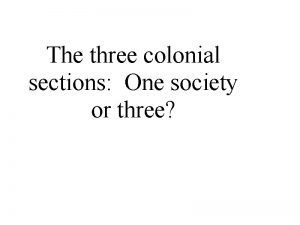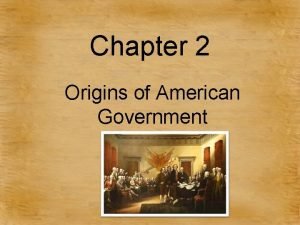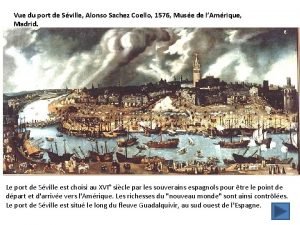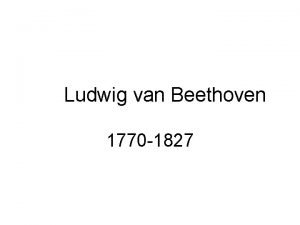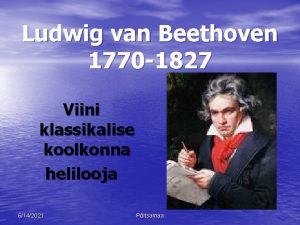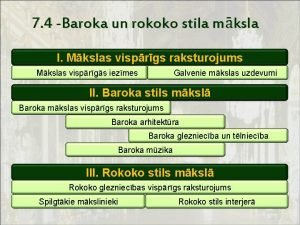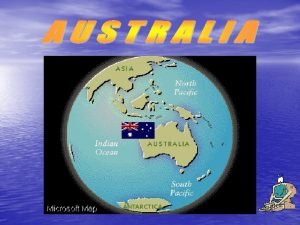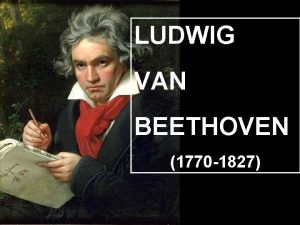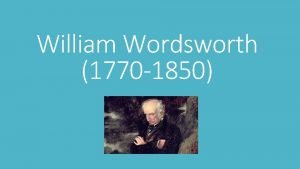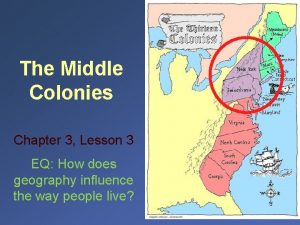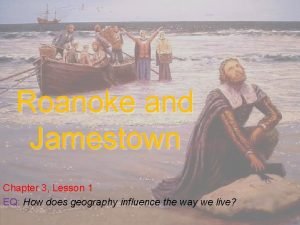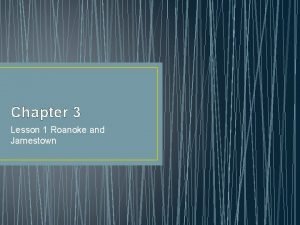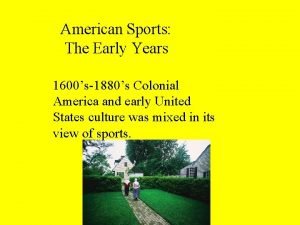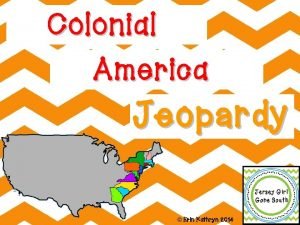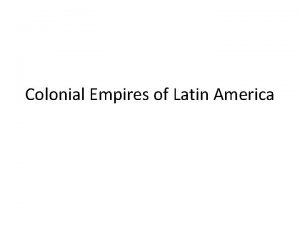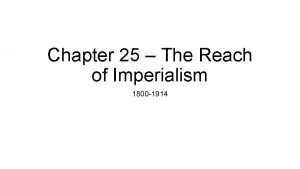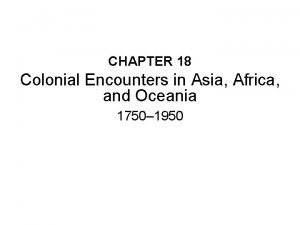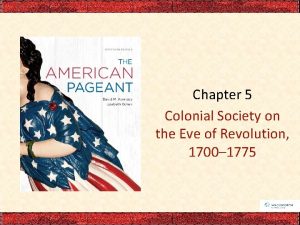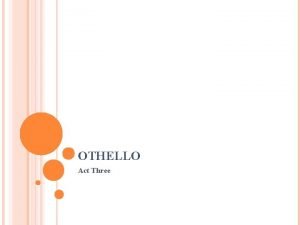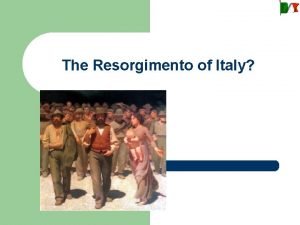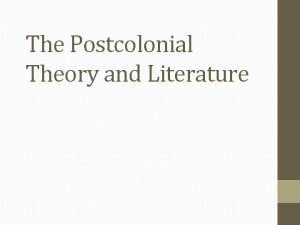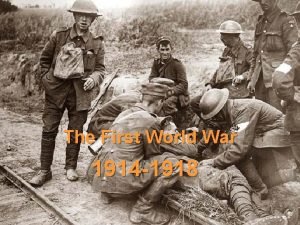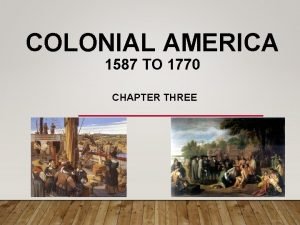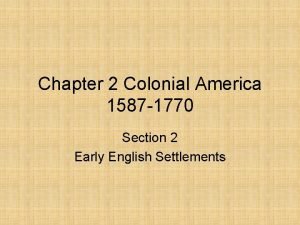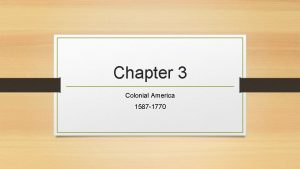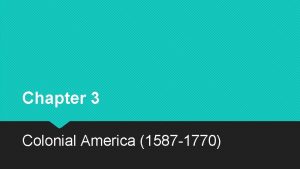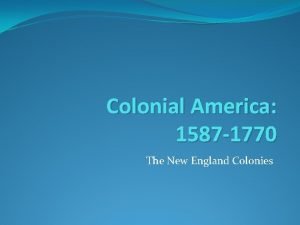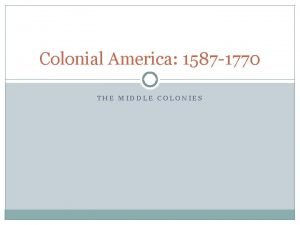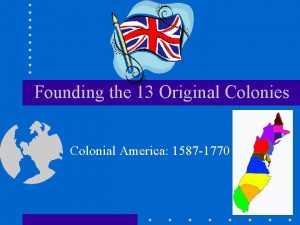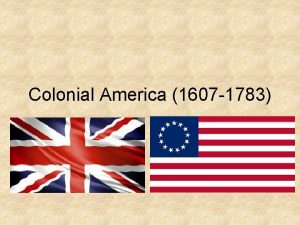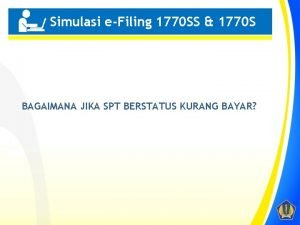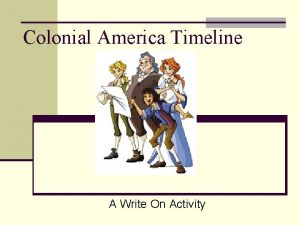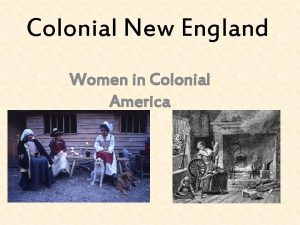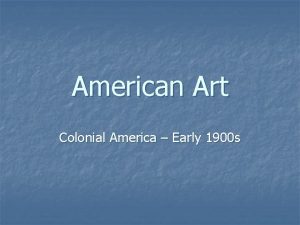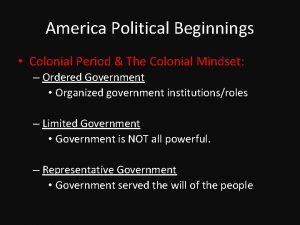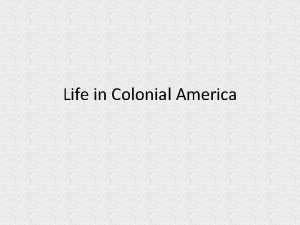Colonial America 1587 to 1770 Chapter Three U








































- Slides: 40

Colonial America 1587 to 1770 Chapter Three U. S. History Mr. Kissam

Section 1 The Southern Colonies

If you were there �A year ago, in 1609, you moved to the colony of Virginia. Life here has been hard. During the winter many people died of cold or sickness. Food is always scarce. Now it is spring, and a ship has come from England bringing supplies. In a week it will sail home. Some of your neighbors are giving up and returning to England. They ask you to come, too. �Would you take the ship back to England?

Settlement in Jamestown �In 1606, the London Company (a joint stock company – investors bought stock in company in hopes for profits) received a charter from King James I to create a colony in America.

“Jamestown” �Three ships with over 140 settlers headed for America and were chased into the James River , on May 14, 1607, by Spanish ships landed in present day Virginia (created “Jamestown”). �Jamestown, was the first permanent English settlement in the North America.

Jamestown Fort

“Jamestown” (VC)

Arrival in Jamestown

Problem with Mosquitoes �The area chosen was good for defense, but too swampy (terrible mosquitoes) and poor soil (for crops). �A lack of preparation cost the colonists their lives, by the time of winter nearly 2/3 rds of the original colonists had died.

Refusal to Work �Another problem was that many refused to work, they wanted to search for gold & riches (refused to do what was necessary for the colony to survive).

Captain John Smith �By 1608, only 38 survived due to the leadership of John Smith (whose “no work, no eat” policy forced colonists to work).

Powhatan � The Powhatan Confederacy helped the colonists after Smith made an agreement with them. � They brought food to help the colonists and taught them how to grow corn.

“Starving Time” � In the winter of 1609 -1610, the “The Starving Time” saw the colony almost collapse due to lack of leadership (Smith was back in England), wars with Native Americans, famine, disease, and freezing storms. Only 1 in 10 survived. � From 1609, the colony had 400 settlers and by the spring of 1610, it had dropped to just 60 settlers. � They resorted to cannibalism and even called someone for being accused as a Catholic spy.

Tobacco �By 1614, Jamestown began making money with the Tobacco that John Rolfe had sent back to England (tobacco was a Native American crop).

John Rolfe and Pocahontas � Rolfe eventually marries Pocahontas , daughter of Powhatan Leader, in 1614 (eases relations between Natives and colonists). � In 1622, after Pocahontas had died in England, the colonists kill the Powhatan Leader. � Fighting would continue for another 20 years.

John Smith & Pocahontas

War in Virginia �By 1624, the London Company was losing money and Native American attacks prompted King James to take over the colony (becomes a “royal colony”). �The King can now appoint a governor to run the colony.

Daily Life in Virginia � In early Virginia, settlers lived on scattered farms then in towns. The headright system established large plantations. � As a result, colonists began to rent out land to grow cash crops to sell back in England (colonists who paid their own way to America were given 100 acres of land). � The “Headright system” gave 50 acres of land for each family member who paid their own way to travel to America (thousands moved to America).

Labor in Virginia �Colonists in Virginia suffered high death rates which led to labor shortages. �The majority of workers were indentured servants. �These servants signed a contract to work for 4 to 7 years for those who paid for their journey to America.

Expansion of Slavery � In 1619 as well, over 90 women were sent to Jamestown (cost 120 pounds of tobacco to buy a wife) and 20 African “indentured servants” arrived (sold to work the plantations for a period of time). �Slavery would replace indentured servants as the demand for labor increased and their was not enough indentured servants to meet the demand.

Expansion of Slavery � Slavery was unknown to English law, nor did colonists rush to pass any laws. The nearest thing to it was indentured servitude. � Some Africans became successful farmers when their contract had ended. � Slavery would not officially appear until the 1660 s. � William Tucker would be the first African American born in the English colonies in America.

“Bacon’s Rebellion” �In the 1640’s, Virginia was growing very wealthy with tobacco and settlers demanded to move farther west into Native American lands. �Poor colonists were upset with paying higher taxes and thought the Governor wasn’t doing enough to protect them from Native American attacks.

“Bacon’s Rebellion” � In 1676, Nathaniel Bacon and a mob attacked some friendly Native Americans. � When the governor tried to stop, Bacon and his supporters attacked him and burned Jamestown down. This is was called “Bacons Rebellion” � (eventually ended with the death of Nathaniel Bacon of illness)

The Other Southern Colonies

The Other Southern Colonies �Many English Catholics came to America to escape religious persecutions. �England’s Catholics had long been against England’s separation from the Roman Catholic Church �For this reason they were not allowed to worship freely by the Church of England.

Maryland �In 1632, the proprietary colony of Maryland was established by Sir George Calvert (Lord Baltimore) as a haven for Catholics and a place to make him wealthy. �A proprietary colony means that the colony’s proprietors, or owners, controlled the government.

Maryland �n 1634, Baltimore's son brought 200 settlers to Maryland settled along the Potomac River (grew tobacco, but also required corn or other crops to be grown so they were not dependent on one crop).

Toleration Act of 1649 �Baltimore would become the largest port city in the colony. �Maryland offered 100 acres of land to every settler who agreed to come to the colony (wealthy plantation owners needed workers also)

Toleration Act of 1649 �The “Toleration Act of 1649” made it crime to restrict religious rights of Christians. It was passed by Lord Baltimore to make sure that both Catholics and Protestants in Maryland could worship freely (to ease the tensions)

The Carolinas and Georgia �In 1663, the proprietary colony of Carolinas (“Charles’ Land”) was created by owners who wanted to make money selling and renting land. �“Charles Town” (Charleston) became the most important city in the colony. �It was a single colony, that was controlled by 8 proprietors.

The Carolinas � Most of the colonists in North Carolina came from Virginia, and most colonists in South Carolina came from Europe. � In 1712, the colonies split into North and South, because they were far apart and hard to govern. � By 1730, nearly 20, 000 enslaved Africans were living in the Carolinas. � By 1729, the colonies of North Carolina and South Carolina became royal colonies (after England took control to settle disputes).

Georgia �In 1733, the colony of Georgia was created as proprietary colony by James Oglethorpe as a way to give English “debtors” and chance to start again �Also to create a buffer with Spanish Florida and the other colonies. �Oglethorpe created the city of Savannah and outlawed slavery, Catholics, and rum.

Georgia �Eventually, thousands of poor Europeans moved to Georgia (not as many English as they wanted). �After many complaints over his rule, Oglethorpe turns Georgia back over to England in 1751 to become a royal colony.

Economies of Southern Colonies �The economies of the southern colonies depended on agriculture. They exported materials for building ships such as wood and tar. �The colonies had many small farms and some large plantations. �Tobacco, rice, and indigo were the most important cash crop.

Tidewater �The “Tidewater” region had the most plantations with the best soil (located on rivers) and was the richest region in the south with the largest numbers of slaves.

“Backcountry” �The “Backcountry or Piedmont” region had the fewest plantations due to poorer soil and was the poorest region in the south with most small farms being worked by family. (Term hillbilly comes from the workers here)

Economies of Southern Colonies � Cash crops required a great deal for difficult work to grow. � By 1700 s, enslaved Africans replaced indentured servants as the main source of labor. � Most southern colonies passed slave codes, or laws to control slaves. Colonies with the largest amount of slaves had the strictest codes. � Olaudah Equiano recorded his experiences as a slave.

Draw and label The Southern Colonies on your notes

Questions pages 72 -77 �When was Jamestown founded? �What was the main cash crop in Virginia? �How were indentured servants different from slaves? �Why did English Catholics settle in the colony of Maryland? �Why did North and South Carolina split? �What were the main cash crops in the southern colonies?

Fill in the Chart Colony Virginia Maryland Carolinas Georgia Year Why Founded Charter or Proprietary Colony
 The three colonial sections-one society or three
The three colonial sections-one society or three Origins of american government chapter 2
Origins of american government chapter 2 Shakespeare career
Shakespeare career Vue du port de séville
Vue du port de séville Mil-std-889
Mil-std-889 Bakit nagtatag ang mga espanyol ng mga paaralan noon
Bakit nagtatag ang mga espanyol ng mga paaralan noon 1770 1827
1770 1827 1770-1827
1770-1827 Svētās terēzes ekstāze
Svētās terēzes ekstāze Who discovered australia in 1770
Who discovered australia in 1770 Ludwig van beethoven (1770-1827)
Ludwig van beethoven (1770-1827) Where is beethoven buried
Where is beethoven buried Did you notice something
Did you notice something Hegel 1770 a 1831
Hegel 1770 a 1831 Wordsworth was born in
Wordsworth was born in Southern colonies entertainment
Southern colonies entertainment Colonial america lesson 3 the middle colonies
Colonial america lesson 3 the middle colonies Guided reading lesson 1 roanoke and jamestown
Guided reading lesson 1 roanoke and jamestown Colonial america lesson 1 roanoke and jamestown answer key
Colonial america lesson 1 roanoke and jamestown answer key Colonial america sports
Colonial america sports Colonial america jeopardy
Colonial america jeopardy Colonial america jeopardy
Colonial america jeopardy Colonial empires in latin america
Colonial empires in latin america We can do a rap of the map of the us
We can do a rap of the map of the us Asia africa europe north america south america
Asia africa europe north america south america Repetition in let america be america again
Repetition in let america be america again Why is it called latin america
Why is it called latin america Performance e body art
Performance e body art The reach of imperialism
The reach of imperialism Chapter 18 colonial encounters in asia and africa
Chapter 18 colonial encounters in asia and africa Lesson 1 colonial economy
Lesson 1 colonial economy Chapter 5 colonial society on the eve of revolution
Chapter 5 colonial society on the eve of revolution The hobbits and orcs problem
The hobbits and orcs problem Othello act three scene three
Othello act three scene three In three minutes write
In three minutes write Traffic signs purpose
Traffic signs purpose Three address code
Three address code Italian colonial ambitions
Italian colonial ambitions Postcolonial theory in literature
Postcolonial theory in literature Modern american floral design
Modern american floral design Colonial empires 1914
Colonial empires 1914
